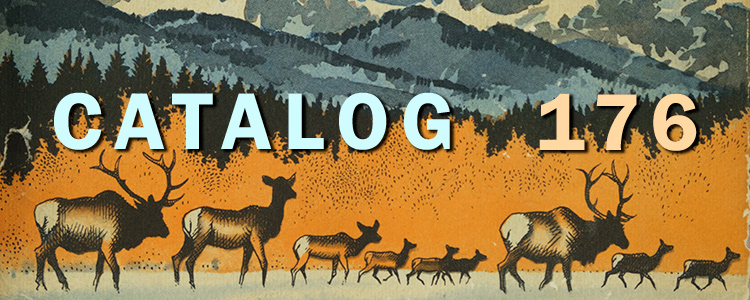Weekly Sale
-
Note: Sale prices are net prices -- no further discounts apply.
All books are first printings of first editions or first American editions unless otherwise noted.
(Washington, D.C.), Survival International U.S.A., (1981-1982). Volume 1, No. 1 and Volume 2, Nos. 2, 3/4. Four issues (one double issue, so 3 items). One issue folded for mailing; two issues sunned; near fine.
[#018432]
$40
$20
$20
(ACKER, Kathy)
 Buffalo, Presence Press, 1968. Four short untitled poems, of a sexual nature, by Acker, in the third issue of this "Magazine of the Revolution," edited by Dan Connell. We found several copies of the first issue of the magazine in OCLC, but no copies of this issue. Stained at the spine base; still near fine in stapled wrappers. Precedes Acker's first book by four years.
[#035092]
$450
Buffalo, Presence Press, 1968. Four short untitled poems, of a sexual nature, by Acker, in the third issue of this "Magazine of the Revolution," edited by Dan Connell. We found several copies of the first issue of the magazine in OCLC, but no copies of this issue. Stained at the spine base; still near fine in stapled wrappers. Precedes Acker's first book by four years.
[#035092]
$450$293
ALDAN, Daisy, ed.
NY, Crowell, (1969). A collection edited by Aldan, who was nominated for the 1979 Pulitzer Prize for Poetry for Between High Tides. Inscribed by Aldan in the year of publication, with a quote from the 11th century poem "Black Marigolds" and "in memory of race horses, with love." Near fine in a very good dust jacket with a pending chip at the spine base.
[#027326]
$95
$48
$48
BAXTER, Charles
 (NY), New Rivers Press, 1974. The second book, a collection of poetry, by the author of First Light, and others. This is the simultaneous issue in wrappers. The total edition was 600 copies, of which 400 were issued in wrappers and 200 in cloth. Baxter's first book was a poetry collection published four years earlier. Well-known these days as a writer of fiction, his first novel wasn't published until 1987, seventeen years after his first book and thirteen years after this volume. Near fine. A scarce title in either the hardcover or softcover issue.
[#006249]
$95
(NY), New Rivers Press, 1974. The second book, a collection of poetry, by the author of First Light, and others. This is the simultaneous issue in wrappers. The total edition was 600 copies, of which 400 were issued in wrappers and 200 in cloth. Baxter's first book was a poetry collection published four years earlier. Well-known these days as a writer of fiction, his first novel wasn't published until 1987, seventeen years after his first book and thirteen years after this volume. Near fine. A scarce title in either the hardcover or softcover issue.
[#006249]
$95$48
BAXTER, Charles
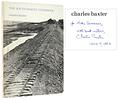 (NY), New Rivers Press, 1974. The scarce hardcover issue of his second book, a collection of poetry. The total edition was 600 copies, of which only 200 were issued in cloth; 400 were issued in wrappers. Well-known these days as a writer of fiction and of essays on fiction, Baxter didn't publish his first novel until 1987, seventeen years after his first book (Chameleon) and thirteen years after this title. Inscribed by the author in 1982. Fine in a slightly rubbed, else fine dust jacket.
[#911007]
$650
(NY), New Rivers Press, 1974. The scarce hardcover issue of his second book, a collection of poetry. The total edition was 600 copies, of which only 200 were issued in cloth; 400 were issued in wrappers. Well-known these days as a writer of fiction and of essays on fiction, Baxter didn't publish his first novel until 1987, seventeen years after his first book (Chameleon) and thirteen years after this title. Inscribed by the author in 1982. Fine in a slightly rubbed, else fine dust jacket.
[#911007]
$650$455
BEATTIE, Ann
Worcester, Metacom Press, 1981. The hardcover issue. The first separate appearance of this short story, which first appeared in Antaeus. Of a total edition of 276 copies, this is one of 26 lettered copies, signed by the author. Fine in a fine dust jacket.
[#911362]
$250
$163
$163
BELL, Madison Smartt
(Brussels), (Fondation Europeenne pour la Sculpture), (1997). Bell provides a bilingual (English/French) fable as introduction to the catalog of work by Jean de la Fontaine: in 1997 the Luxembourg artist had installed his "Love of Camping" in a Brussels park. Number 452 of 500 numbered copies. Fine in stapled wrappers. A scarce piece by Bell, attractively illustrated.
[#917040]
$150
$98
$98
BOYD, William
 (London), Bridgewater Press, (2000). Of a total edition of 138 copies, this is copy VII of 12 Roman-numeraled copies bound in quarter Library Calf, with a signed original drawing by Boyd, tipped in as frontispiece. Signed by the author. Fine.
[#914614]
$750
(London), Bridgewater Press, (2000). Of a total edition of 138 copies, this is copy VII of 12 Roman-numeraled copies bound in quarter Library Calf, with a signed original drawing by Boyd, tipped in as frontispiece. Signed by the author. Fine.
[#914614]
$750$525
(BURROUGHS, John)
 Boston, Houghton Mifflin, 1912. Burroughs provides an 8-page introduction to this collection of "Outdoor Scenes and Thoughts From the Writings of Walt Whitman," as compiled by Waldo R. Browne. Says Burroughs, in part, "As a poet he did not specialize upon flowers or birds or scenery, or any of the mere prettiness of nature, but he thought of wholes, he tried himself by wholes, he emulated the insouciance, the impartiality, the mass movements of the earth." Trace shelf wear; a very near fine copy in a good dust jacket: chipped at both spine ends and rear corners, and fragile at the folds. Uncommon in the original edition; scarce in any jacket.
[#035119]
$300
Boston, Houghton Mifflin, 1912. Burroughs provides an 8-page introduction to this collection of "Outdoor Scenes and Thoughts From the Writings of Walt Whitman," as compiled by Waldo R. Browne. Says Burroughs, in part, "As a poet he did not specialize upon flowers or birds or scenery, or any of the mere prettiness of nature, but he thought of wholes, he tried himself by wholes, he emulated the insouciance, the impartiality, the mass movements of the earth." Trace shelf wear; a very near fine copy in a good dust jacket: chipped at both spine ends and rear corners, and fragile at the folds. Uncommon in the original edition; scarce in any jacket.
[#035119]
$300$195
CAREY, Peter
London, Belmont Press, 2002. Of a total edition of 226, this is the "standard" issue, one of 100 numbered copies signed by Carey and by the illustrator, Eileen Hogan. Fine, without dust jacket, as issued.
[#911433]
$450
$293
$293
CASTILLO, Ana
Houston, Arte Publico Press, 1984. Inscribed by the author in 1986. Fine in wrappers.
[#914438]
$150
$98
$98
COETZEE, J.M.
 London, Secker & Warburg, (1983). The first British edition of the first Booker Prize-winning novel by the South African Nobel Prize-winning author. Tap to spine crown; else fine in a fine dust jacket.
[#912381]
$100
London, Secker & Warburg, (1983). The first British edition of the first Booker Prize-winning novel by the South African Nobel Prize-winning author. Tap to spine crown; else fine in a fine dust jacket.
[#912381]
$100$65
COLLIER, John
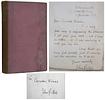 London, Peter Davies, 1930. His first and most famous novel, describing the marriage between an explorer and his pet chimpanzee. This copy is inscribed by Collier to Welsh author Caradoc Evans, with an autograph letter signed by Collier to Evans tipped in at the front pastedown. The letter, dated December 5, 1930, expresses pleasure in reading his, Evans', book and conveys his own book in return. A copy of Evans' book, Nothing to Pay (Faber, 1930), is included. His Monkey Wife is unjacketed; but for some staining and wear to the front board and a tiny owner name on the front flyleaf, a very good copy, and a nice association.
[#035295]
$500
London, Peter Davies, 1930. His first and most famous novel, describing the marriage between an explorer and his pet chimpanzee. This copy is inscribed by Collier to Welsh author Caradoc Evans, with an autograph letter signed by Collier to Evans tipped in at the front pastedown. The letter, dated December 5, 1930, expresses pleasure in reading his, Evans', book and conveys his own book in return. A copy of Evans' book, Nothing to Pay (Faber, 1930), is included. His Monkey Wife is unjacketed; but for some staining and wear to the front board and a tiny owner name on the front flyleaf, a very good copy, and a nice association.
[#035295]
$500$325
COMMONER, Barry
 St. Louis, Center for the Biology of Natural Systems, 1975. The partial text (so stated, by design) of Commoner's address before the National Press Photographers Association Education Seminar in Jackson Hole in 1975, on the subject of nuclear energy. Commoner derides the lack of attention paid to the relationship between ecosystems and economic systems. Solutions are given in the following part of the address, not included here. Stapled wrappers: foxing to cover, rust to staples; near fine. No copies in OCLC.
[#036236]
$250
St. Louis, Center for the Biology of Natural Systems, 1975. The partial text (so stated, by design) of Commoner's address before the National Press Photographers Association Education Seminar in Jackson Hole in 1975, on the subject of nuclear energy. Commoner derides the lack of attention paid to the relationship between ecosystems and economic systems. Solutions are given in the following part of the address, not included here. Stapled wrappers: foxing to cover, rust to staples; near fine. No copies in OCLC.
[#036236]
$250$163
CROWLEY, John
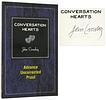 (Burton), Subterranean, 2008. The advance reading copy of these two intertwined stories, one that takes place on Earth, the other a children's story that takes place on another planet. Signed by the author. Crowley is one of our most highly regarded fantasy writers, having won the World Fantasy Award for a novel, Little, Big in 1982; a novella, "Great Work of Time," in 1990; and for Life Achievement, in 2006. Minor cover splaying; near fine in wrappers. Scarce in this advance issue, especially signed.
[#033925]
$175
(Burton), Subterranean, 2008. The advance reading copy of these two intertwined stories, one that takes place on Earth, the other a children's story that takes place on another planet. Signed by the author. Crowley is one of our most highly regarded fantasy writers, having won the World Fantasy Award for a novel, Little, Big in 1982; a novella, "Great Work of Time," in 1990; and for Life Achievement, in 2006. Minor cover splaying; near fine in wrappers. Scarce in this advance issue, especially signed.
[#033925]
$175$114
(DAHLBERG, Edward)
Chicago, Poetry, 1953. Warmly and lengthily inscribed by Dahlberg at his contribution, "Ushant, A Long Lotus Sleep," an excerpt from a work-in-progress. Near fine in wrappers.
[#017387]
$95
$48
$48
(Edinburgh Magazine)
NY, Theodore Foster/William Lewer, 1837. February, July, and October issues. The July issue is lacking its covers. Moderate foxing; some staining to covers; good copies overall.
[#600029]
$75
$38
$38
EDSON, Russell
NY, Harper & Row, (1976). The simultaneous issue in wrappers. Near fine. David Ignatow blurb.
[#036070]
$85
$43
$43
(Film)
 Gorham/Portland, [University of Southern Maine], 1971. Poster advertising two dates for a showing of a film "featuring a history of experimental cartoon work and animation" by Charley Murphy and Stan Vanderbeek, and "a new film by Kenneth Anger," plus a "surprise film." 14-1/2" x 16". Black on gold; near fine.
[#033333]
$100
Gorham/Portland, [University of Southern Maine], 1971. Poster advertising two dates for a showing of a film "featuring a history of experimental cartoon work and animation" by Charley Murphy and Stan Vanderbeek, and "a new film by Kenneth Anger," plus a "surprise film." 14-1/2" x 16". Black on gold; near fine.
[#033333]
$100$65
FORD, Richard
 (n.p.), (n.p.), 1988. A 120-page screenplay by Ford for a 1991 film adaptation he did from stories in his collection Rock Springs. The film was directed by Michael Fields and starred Dermot Mulroney, Lili Taylor, Sam Shepard and Valerie Perrine. Apparently a later generation photocopy, as the text is less sharp; also the rectos of the pages tend to stick to the versos of the pages preceding. This copy is signed by the author. Near fine, in maroon binder.
[#911203]
$1,000
(n.p.), (n.p.), 1988. A 120-page screenplay by Ford for a 1991 film adaptation he did from stories in his collection Rock Springs. The film was directed by Michael Fields and starred Dermot Mulroney, Lili Taylor, Sam Shepard and Valerie Perrine. Apparently a later generation photocopy, as the text is less sharp; also the rectos of the pages tend to stick to the versos of the pages preceding. This copy is signed by the author. Near fine, in maroon binder.
[#911203]
$1,000$700
GOGARTY, Oliver St. John
 Baltimore, Contemporary Poetry, 1944. A collection of poems, one of 1000 copies. A nice association copy, inscribed by the author to a painter, the wife (for a time) of a poet. A fine copy in a worn dust jacket severed at the spine. A fragile wartime book.
[#016232]
$250
Baltimore, Contemporary Poetry, 1944. A collection of poems, one of 1000 copies. A nice association copy, inscribed by the author to a painter, the wife (for a time) of a poet. A fine copy in a worn dust jacket severed at the spine. A fragile wartime book.
[#016232]
$250$163
HOGAN, James P.
NY, Ballantine/Del Rey, (1978). The hardcover issue. Fine in a fine dust jacket.
[#916291]
$150
$98
$98
IGNATOW, David
September 14, 1978. To the editors of Farrar, Straus & Giroux: "I'm taking the liberty of submitting to you a ms. of short stories, not mine, that I think is worthy of consideration for publication..." The author on whose behalf Ignatow is writing is unnamed, although he does add that Grace Paley is interested in writing an introduction. One corner staple; editorial "logged in" remarks; folded in thirds; and typed on a machine that made only partial "o's." Near fine.
[#013665]
$40
$20
$20
IRVING, John
 (n.p.), (n.p.), 2000. An early, tapebound typescript of this novel that was published in July, 2001. No publisher indicated, suggesting this was an early agent's copy, or some other kind of copy prepared prior to the publisher issuing any version of it. Double-spaced, double-sided, 507 pages. "Revised: December 11, 2000" printed on the white front cover/title page. Textual differences exist between this and the published text, beginning with a different table of contents and including changes in the Acknowledgments section of the book. We are aware of another state of this draft that was comb-bound, which was issued by Knopf/Canada. Very near fine.
[#030737]
$450
(n.p.), (n.p.), 2000. An early, tapebound typescript of this novel that was published in July, 2001. No publisher indicated, suggesting this was an early agent's copy, or some other kind of copy prepared prior to the publisher issuing any version of it. Double-spaced, double-sided, 507 pages. "Revised: December 11, 2000" printed on the white front cover/title page. Textual differences exist between this and the published text, beginning with a different table of contents and including changes in the Acknowledgments section of the book. We are aware of another state of this draft that was comb-bound, which was issued by Knopf/Canada. Very near fine.
[#030737]
$450$293
JACKSON, Jon A.
 NY, Atlantic Monthly, (2002). The advance reading copy of this mystery/thriller. Fine in wrappers.
[#035009]
$65
NY, Atlantic Monthly, (2002). The advance reading copy of this mystery/thriller. Fine in wrappers.
[#035009]
$65$33
(KAEL, Pauline)
 Yellow Springs, Antioch College Union, 1961. The first (only?) issue of this magazine of literature and the arts. This copy is inscribed to Pauline Kael by Herbert Feinstein at his contribution, about Satyaji Ray's film The World of Apu. Kael has written "Feinstein on Apu" on the rear cover. Lower front cover corner crease; some rubbing and handling; very good in stapled wrappers.
[#036223]
$300
Yellow Springs, Antioch College Union, 1961. The first (only?) issue of this magazine of literature and the arts. This copy is inscribed to Pauline Kael by Herbert Feinstein at his contribution, about Satyaji Ray's film The World of Apu. Kael has written "Feinstein on Apu" on the rear cover. Lower front cover corner crease; some rubbing and handling; very good in stapled wrappers.
[#036223]
$300$195
KENNEDY, Eugene
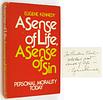 Garden City, Doubleday, 1975. A book on "Personal Morality Today" by a Catholic priest. Inscribed by the author to Pauline Kael, "who has a great sense of life." Slightly musty; near fine in a spine-faded, thus very good, dust jacket.
[#034559]
SOLD
Garden City, Doubleday, 1975. A book on "Personal Morality Today" by a Catholic priest. Inscribed by the author to Pauline Kael, "who has a great sense of life." Slightly musty; near fine in a spine-faded, thus very good, dust jacket.
[#034559]
SOLD
(Nature)
KILHAM, Lawrence
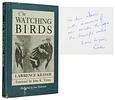 Chelsea, Chelsea Green Publishing Company, (1988). Winner of the 1989 John Burroughs Medal. Inscribed by the author on the title page. As the title suggests, not just a book about birds, but also about how to observe them. With a foreword by the 1971 Burroughs Medal winner, John K. Terres. Nonauthorial gift inscription on the first blank, to the same recipients as Kilham's inscription. A fine copy in a very good, price-clipped dust jacket with several internally tape-mended edge tears.
[#036438]
$275
Chelsea, Chelsea Green Publishing Company, (1988). Winner of the 1989 John Burroughs Medal. Inscribed by the author on the title page. As the title suggests, not just a book about birds, but also about how to observe them. With a foreword by the 1971 Burroughs Medal winner, John K. Terres. Nonauthorial gift inscription on the first blank, to the same recipients as Kilham's inscription. A fine copy in a very good, price-clipped dust jacket with several internally tape-mended edge tears.
[#036438]
$275$179
LANDESMAN, Fran
(London), Sun Tavern Fields, (1992). Inscribed by the author to Robert Stone and his wife, with "much love." Fine in wrappers.
[#033797]
$50
$25
$25
(LEE, Harper)
 Tuscaloosa, University of Alabama, 1947-1948. Two volumes of the yearbook of the University of Alabama, where Harper Lee studied law between 1945 and 1949. The 1947 Corolla shows Lee as editor of the humor magazine Rammer Jammer; sitting on the Board of Publications; voted one of the "campus personalities"; pictured as a student of law; and as a member of Chi Omega and of Triangle, an honor society of seniors who guide freshmen. In all, at least a half dozen pictures of Lee. Wear to the edges, rubbing to the joints; near fine. The 1948 Corolla pictures Lee only as a campus personality: before completing her degree requirements, Lee left law school for New York City, where she worked as an airline reservations clerk (and wrote To Kill A Mockingbird). From Lee's campus newspaper, as quoted in the book Harper Lee by Kerry Madden: "[Lee] is a traditional and impressive figure as she strides down the corridor of New Hall at all hours attired in men's green striped pajamas. Quite frequently she passes out candy to unsuspecting freshman; when she emerges from their rooms they have subscribed to the Rammer Jammer." Check marks in text; board edges worn; very good.
[#023675]
$1,000
Tuscaloosa, University of Alabama, 1947-1948. Two volumes of the yearbook of the University of Alabama, where Harper Lee studied law between 1945 and 1949. The 1947 Corolla shows Lee as editor of the humor magazine Rammer Jammer; sitting on the Board of Publications; voted one of the "campus personalities"; pictured as a student of law; and as a member of Chi Omega and of Triangle, an honor society of seniors who guide freshmen. In all, at least a half dozen pictures of Lee. Wear to the edges, rubbing to the joints; near fine. The 1948 Corolla pictures Lee only as a campus personality: before completing her degree requirements, Lee left law school for New York City, where she worked as an airline reservations clerk (and wrote To Kill A Mockingbird). From Lee's campus newspaper, as quoted in the book Harper Lee by Kerry Madden: "[Lee] is a traditional and impressive figure as she strides down the corridor of New Hall at all hours attired in men's green striped pajamas. Quite frequently she passes out candy to unsuspecting freshman; when she emerges from their rooms they have subscribed to the Rammer Jammer." Check marks in text; board edges worn; very good.
[#023675]
$1,000$700
(Legion D'Honneur)
NY, American Society of the French Legion of Honor, 1930-1938. The first 32 issues (Vol. 1 #1 through Vol. 8 #4) of this magazine edited by W. Francklin Paris and dedicated to fostering understanding between France and the U.S. Four volumes: half bound in green leather and marbled boards, with marbled endpages. Contents fine, but the leather is rubbed at the joints and ends, thus a very good set.
[#600041]
$450
$293
$293
LEUCI, Bob
NY, New American Library, (1989). The advance reading copy. Inscribed by the author (but not signed) to Robert Stone and his wife. Very good in wrappers.
[#033747]
$75
$38
$38
LITTLEHEART, Oleta
Sulphur, Abbott, 1908 [1909]. A collection of tales that appears to be an autobiographical novel written by a Chickasaw woman, but is, according to Marable and Boylan's A Handbook of Oklahoma Writers [Norman: University of Oklahoma Press, 1939], authored by the publisher, Aaron Abbott. Title page states 1908; printed letters on verso dated 1909. Owner name front cover; chip to lower spine; about very good in wrappers.
[#036399]
$200
$130
$130
MATHESON, Richard
 Philadelphia, Chamberlain Press, 1954. Matheson's first hardcover publication, a collection of stories with an introduction by Robert Bloch, who later wrote Psycho. About 650 copies of this book had been distributed prior to a flood that destroyed the remaining bound copies, and a fire later destroyed the unbound sheets. Inscribed by Matheson to the horror writer Stanley Wiater, in 1992: "To Stanley -- with many thanks for the excellent interview in Dark Dreamers. Best always, Richard Matheson." Matheson's career began with placing short stories in the pulp magazines, and he later became one of the most important script writers for "The Twilight Zone." Ray Bradbury called him "one of the most important writers of the 20th century," and Stephen King cited him as "the author who most influenced me as a writer." A nice association copy. Wiater's bookplate on front pastedown. Lower boards show some water damage, text block fine, but still only a good copy in a good, damp-stained dust jacket with effects mostly visible on verso and rear panel.
[#030756]
$450
Philadelphia, Chamberlain Press, 1954. Matheson's first hardcover publication, a collection of stories with an introduction by Robert Bloch, who later wrote Psycho. About 650 copies of this book had been distributed prior to a flood that destroyed the remaining bound copies, and a fire later destroyed the unbound sheets. Inscribed by Matheson to the horror writer Stanley Wiater, in 1992: "To Stanley -- with many thanks for the excellent interview in Dark Dreamers. Best always, Richard Matheson." Matheson's career began with placing short stories in the pulp magazines, and he later became one of the most important script writers for "The Twilight Zone." Ray Bradbury called him "one of the most important writers of the 20th century," and Stephen King cited him as "the author who most influenced me as a writer." A nice association copy. Wiater's bookplate on front pastedown. Lower boards show some water damage, text block fine, but still only a good copy in a good, damp-stained dust jacket with effects mostly visible on verso and rear panel.
[#030756]
$450$293
(McSweeney's Store)
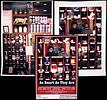 [2005]. Three broadsheets showing the development of advertising material for the documentary by Joe Pacheco about One Ring Zero, the "house band" for the McSweeney's Store in Brooklyn and their collaborations with McSweeney's roster of authors. Readings at the store would be accompanied by One Ring Zero; the band solicited lyrics from the authors and created an album of the resulting songs -- "As Smart as We Are"; and Pacheco made a movie about the process, and created the advertising for a benefit screening. Included here: a 13" x 19" color photo by Pacheco of the postal shelving used by the store, with one odd object per cubbyhole; a second 13" x 19" poster replacing some of those objects with authors and the band One Ring Zero; and a third, finished poster, 11" x 17", replacing some of those authors with text advertising the benefit screening (at 826NYC, as the Store had closed by 2005). Fine.
[#032962]
$375
[2005]. Three broadsheets showing the development of advertising material for the documentary by Joe Pacheco about One Ring Zero, the "house band" for the McSweeney's Store in Brooklyn and their collaborations with McSweeney's roster of authors. Readings at the store would be accompanied by One Ring Zero; the band solicited lyrics from the authors and created an album of the resulting songs -- "As Smart as We Are"; and Pacheco made a movie about the process, and created the advertising for a benefit screening. Included here: a 13" x 19" color photo by Pacheco of the postal shelving used by the store, with one odd object per cubbyhole; a second 13" x 19" poster replacing some of those objects with authors and the band One Ring Zero; and a third, finished poster, 11" x 17", replacing some of those authors with text advertising the benefit screening (at 826NYC, as the Store had closed by 2005). Fine.
[#032962]
$375$244
O'BRIAN, Patrick
NY, Norton, (1995). The uncorrected proof copy of the first American edition of this nonfiction overview of life in the 18th century British navy, intended in part as a companion volume to his Aubrey/Maturin series. Small thin quarto, heavily illustrated (although the proof reproductions are of poor quality). One slight corner crease; else fine in wrappers.
[#014909]
$40
$20
$20
OLSON, Neil
(NY), HarperCollins, (2005). Inscribed by the author to Robert Stone and his wife: "Thanks for the inspiration! Enjoy." Fine in a fine dust jacket. With an interview with Olson laid in.
[#033766]
$45
$23
$23
PINTAURO, Joe
NY, Broadway Play Publishing, (1990). A play by this poet, playwright, essayist and novelist. His novel Cold Hands was chosen as New York Times Notable Book. Inscribed by the author: "Tony [Harvey] -- Thanks for lunch. Joe." Near fine in wrappers.
[#026853]
$40
$20
$20
PURDY, James
 (n.p.), (n.p.), 1961/1962. Mimeographed typescripts of two one-act plays, which were collected in his 1962 volume entitled Children is All. Inscribed by Purdy on the title page of Cracks to the poet Quentin Stevenson "with the sincere admiration of James" and additionally signed, James Purdy. Purdy was a controversial author whose works explored gay themes at a time when this was taboo; his popularity and critical reception suffered as a result, but many of his more celebrated contemporaries considered him a genius and a great writer, among them being Tennessee Williams (who wrote a blurb for the book publication of Children is All); Edward Albee (who produced Purdy's play Malcolm); and Gore Vidal, who called him "an authentic American genius" and wrote in the New York Times article entitled "James Purdy: The Novelist as Outlaw" that "Some writers do not gain wide acceptance because their work is genuinely disturbing. Purdy is one of them." As best we can determine, OCLC lists only two copies of the former typescript and one of the latter in institutional collections. Another collection lists "photocopies" of these two plays, but these productions predate plain paper photocopying. Children is All (1961) runs 41 pages; Cracks (1962) runs 16 pages. Each is near fine; stapled in the upper left corner. Scarce works by a writer Jonathan Franzen called "one of the most undervalued and underread writers in America."
[#031486]
$1,500
(n.p.), (n.p.), 1961/1962. Mimeographed typescripts of two one-act plays, which were collected in his 1962 volume entitled Children is All. Inscribed by Purdy on the title page of Cracks to the poet Quentin Stevenson "with the sincere admiration of James" and additionally signed, James Purdy. Purdy was a controversial author whose works explored gay themes at a time when this was taboo; his popularity and critical reception suffered as a result, but many of his more celebrated contemporaries considered him a genius and a great writer, among them being Tennessee Williams (who wrote a blurb for the book publication of Children is All); Edward Albee (who produced Purdy's play Malcolm); and Gore Vidal, who called him "an authentic American genius" and wrote in the New York Times article entitled "James Purdy: The Novelist as Outlaw" that "Some writers do not gain wide acceptance because their work is genuinely disturbing. Purdy is one of them." As best we can determine, OCLC lists only two copies of the former typescript and one of the latter in institutional collections. Another collection lists "photocopies" of these two plays, but these productions predate plain paper photocopying. Children is All (1961) runs 41 pages; Cracks (1962) runs 16 pages. Each is near fine; stapled in the upper left corner. Scarce works by a writer Jonathan Franzen called "one of the most undervalued and underread writers in America."
[#031486]
$1,500$1,125
PYNE, Daniel
 Los Angeles, Bauer Benedek, (1987). Photocopied screenplay for the spooky thriller directed by John Schlesinger, who also did The Day of the Locust, Marathon Man, The Falcon and the Snowman and others. In an agency binder, with a cover letter from the agency to a novelist laid in. Fine.
[#019022]
$95
Los Angeles, Bauer Benedek, (1987). Photocopied screenplay for the spooky thriller directed by John Schlesinger, who also did The Day of the Locust, Marathon Man, The Falcon and the Snowman and others. In an agency binder, with a cover letter from the agency to a novelist laid in. Fine.
[#019022]
$95$48
RANDALL, Margaret
 New Rochelle, Elizabeth Press, (1968). Inscribed by Randall to the British playwright Arnold Wesker in 1968: "For Arnold - w/all good wishes, Margaret/ 5.68." Randall, in addition to being a poet, co-founded El Corno Emplumado, a bilingual literary journal in Mexico that featured new writing from the Americas and elsewhere, until it was forced to close by the Mexican government after Randall's outspoken support of the Mexican student movement in 1968, and her criticism of the government's violent and deadly response to it. This is a fine copy in a very good dust jacket marred by a coffee stain near the lower spine, mostly on the rear panel.
[#035324]
$100
New Rochelle, Elizabeth Press, (1968). Inscribed by Randall to the British playwright Arnold Wesker in 1968: "For Arnold - w/all good wishes, Margaret/ 5.68." Randall, in addition to being a poet, co-founded El Corno Emplumado, a bilingual literary journal in Mexico that featured new writing from the Americas and elsewhere, until it was forced to close by the Mexican government after Randall's outspoken support of the Mexican student movement in 1968, and her criticism of the government's violent and deadly response to it. This is a fine copy in a very good dust jacket marred by a coffee stain near the lower spine, mostly on the rear panel.
[#035324]
$100$65
(ROBBINS, Tom)
(various places), (various publishers), (1977-2000). Six magazines with pieces by and about Robbins. Two articles and four interviews, as follows: an interview in Rolling Stone, November 1977; a brief essay on living in La Conner, WA in Pacific Northwest, April 1986; an interview in Interview, November 1993; an interview in Seattle Weekly, April, 1994; a cover article on living in the Northwest in Seattle Times, August, 1994, (plus a newspaper ad for the same) and, lastly, an interview in High Times, June 2000. All issues are near fine or better, and span his career from the year after Even Cowgirls Get the Blues to Fierce Invalids from Hot Climates.
[#023608]
$40
$20
$20
(Comics)
ROBBINS, Trina
 Berkeley, Last Gasp, 1970. The first issue (blue and purple background on cover) of the first comic produced entirely by women: Trina Robbins, Barbara "Willy" Mendes, "Hurricane" Nancy Kalish, Carole Kalish, Lisa Lyons, Meredith Kurtzman, and Michele Brand. This comic was a spin off from the first feminist newspaper, also called It Ain't Me Babe, which was started by Berkeley Women's Liberation earlier in 1970. After the comic had gone through several printings, Last Gasp began publishing Wimmen's Comix, which ran for 20 years. Some toning to the pages; a bit of rubbing to the front cover; near fine.
[#036446]
$350
Berkeley, Last Gasp, 1970. The first issue (blue and purple background on cover) of the first comic produced entirely by women: Trina Robbins, Barbara "Willy" Mendes, "Hurricane" Nancy Kalish, Carole Kalish, Lisa Lyons, Meredith Kurtzman, and Michele Brand. This comic was a spin off from the first feminist newspaper, also called It Ain't Me Babe, which was started by Berkeley Women's Liberation earlier in 1970. After the comic had gone through several printings, Last Gasp began publishing Wimmen's Comix, which ran for 20 years. Some toning to the pages; a bit of rubbing to the front cover; near fine.
[#036446]
$350$228
ROTHENBERG, Jerome
(Greensboro), Unicorn Press, (1974). Poems from the "Poland 1931" sequence. Inscribed by Rothenberg to Clayton [Eshleman], "with admiration & thanks for the encouragements & challenge." Illustrated with posed photographs featuring Rothenberg and Kathy Acker, among others. One of 2000 copies in wrappers. Near fine.
[#033542]
SOLD
ROTHENBERG, Jerome
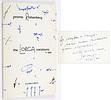 La Laguna, Zasterle Press, 1990. Number 51 of 300 numbered copies. Inscribed by Rothenberg to Clayton [Eshleman] & Caryl: "some more invasions from elsewhere, with much love." Rothenberg was working on translations of Lorca at the time he wrote these poems; both he and Eshleman have translated Spanish language poetry, in addition to sharing an interest in indigenous, tribal, and prehistoric arts. Near fine in wrappers.
[#033557]
$100
La Laguna, Zasterle Press, 1990. Number 51 of 300 numbered copies. Inscribed by Rothenberg to Clayton [Eshleman] & Caryl: "some more invasions from elsewhere, with much love." Rothenberg was working on translations of Lorca at the time he wrote these poems; both he and Eshleman have translated Spanish language poetry, in addition to sharing an interest in indigenous, tribal, and prehistoric arts. Near fine in wrappers.
[#033557]
$100$65
SMITH, Charlie
NY, Dutton, (1987). A review copy of this collection of poetry. Mild age toning to pages, else fine in a fine dust jacket, with review slip, author photo and promotional pages laid in.
[#916868]
$100
$65
$65
STONE, Robert
(London), Picador, 1988, 1998. Two first printings of British paperback reissues of his National Book Award-winning second novel, from the author's own library. The 1988 issue has a dampstain as the lower edge and is near fine; the 1998 issue is fine. Together with a 1981 second printing Houghton Mifflin paperback, also from the author's library; near fine.
[#033839]
$50
$25
$25
THOMAS, Lewis
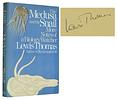 NY, Viking, (1979). His second collection of essays, after The Lives of the Cell won two National Book Awards in 1975. Signed by the author. Fine in a near fine dust jacket with a short, closed edge tear to the upper front panel.
[#036205]
$250
NY, Viking, (1979). His second collection of essays, after The Lives of the Cell won two National Book Awards in 1975. Signed by the author. Fine in a near fine dust jacket with a short, closed edge tear to the upper front panel.
[#036205]
$250$163
(UPDIKE, John)
 (n.p.), (n.p.), 1978. Transcript of two consecutive nights of Updike's appearances on The Dick Cavett Show in December 1978. Ten pages and eleven pages, respectively, plus cover sheet. Printed on rectos only. Near fine, in a blue acetate folder that has split along its fold. DeBellis and Broomfield A68. Later collected in Conversations with John Updike.
[#030282]
$375
(n.p.), (n.p.), 1978. Transcript of two consecutive nights of Updike's appearances on The Dick Cavett Show in December 1978. Ten pages and eleven pages, respectively, plus cover sheet. Printed on rectos only. Near fine, in a blue acetate folder that has split along its fold. DeBellis and Broomfield A68. Later collected in Conversations with John Updike.
[#030282]
$375$244
WALLJASPER, Jay
 NY, The New Press, (2010). A former editor of the Utne Reader explains "how to save the economy, the environment, the internet, democracy, our communities, and everything else that belongs to all of us" by way of acknowledging shared ownership and shared responsibility. Dozens of short articles written by more than two dozen authors, with illustrations and a resource guide, and featuring an introduction by Bill McKibben. Inscribed by Walljasper, with the exhortation "Viva la Commons!" Fine in wrappers.
[#034650]
$100
NY, The New Press, (2010). A former editor of the Utne Reader explains "how to save the economy, the environment, the internet, democracy, our communities, and everything else that belongs to all of us" by way of acknowledging shared ownership and shared responsibility. Dozens of short articles written by more than two dozen authors, with illustrations and a resource guide, and featuring an introduction by Bill McKibben. Inscribed by Walljasper, with the exhortation "Viva la Commons!" Fine in wrappers.
[#034650]
$100$65
(Sixties)
WATTS, Alan W
 London, Thames and Hudson, (1958). The first British edition. Watts explores Man's alienation from nature and its parallel in sexual anxiety with women, positing that approaching sexuality and the sexual act as sacred provides an avenue for spiritually reintegrating with the natural world and our own nature. Foxing to endpages and page edges; very good in a very good, sunned and foxed dust jacket with modest edge wear.
[#036487]
$250
London, Thames and Hudson, (1958). The first British edition. Watts explores Man's alienation from nature and its parallel in sexual anxiety with women, positing that approaching sexuality and the sexual act as sacred provides an avenue for spiritually reintegrating with the natural world and our own nature. Foxing to endpages and page edges; very good in a very good, sunned and foxed dust jacket with modest edge wear.
[#036487]
$250$163
WELSH, Irvine
(London), Vintage, (2003). Fourth printing of the paperback edition. Inscribed by Welsh to the novelist Robert Stone: "Some writing returned with thanks, borrowed from yourself many moons ago. May all good things come your way" and signed "Irvine." Food stains to the first few pages; light cover creasing; very good in wrappers.
[#027778]
$60
$30
$30
For notifications of our sale lists, new arrivals, new catalogs, or other e-lists, subscribe to our email list:
